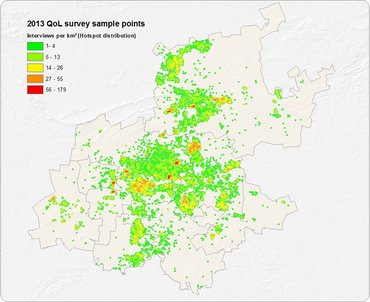|
2013 QoL Survey Viewer
|

|
The 2013 GCRO QoL III survey consists of a total sample of 27490 interviews
across the Gauteng province (no respondents were sampled outside of the province) and
provides a range of measures such as service delivery, satisfaction with government, transport and
mobility, decent work, migration, respondents’ values and attitudes and a quality
of life index. The 2013 survey, as the third in a series of QoL surveys will also allow for basic
trend analysis with a degree of confidence. As a result of a co-investment by the three metropolitan
municipalities – Ekurhuleni, Johannesburg and Tshwane – a minimum sample of 30 respondents per ward
in the non-metro municipalities, and a minimum of 60 in each of the metro’s wards was achieved.
The data can therefore be analysed at a provincial, municipal or ward-level.
The field work was undertaken by Geospace in July 2013, following a highly competitive
tender, using a digital questionnaire designed in Formhub and tablet devices. In August,
GCRO finalised the design of a revised questionnaire which balanced time-series data and
indices from the 2009 and 2011 QoL surveys, with new questions informed by GCRO’s latest
projects and input from local and provincial stakeholders.
|
|
The 2011 local election wards were used as the primary sampling unit, based on the adult population per ward from the
Statistics South Africa Census 2011 data and taking into consideration the minimum targets
of 30/60 per non-metro/metro ward described above. Random sampling occurred at a Small
Area Layer (SAL) level within each ward.
All 508 wards in Gauteng were surveyed, with the mining houses once again proving a major
obstruction to accessing the people living in mining quarters (in one Westonaria ward only
4 interviews were completed). As were the housing estates and gated communities,
with fieldworkers threatened or escorted out of the area at gunpoint. A separate company
was hired to undertake back-checking to ensure quality, and the back-check teams were in
field throughout the fieldwork process. Quality control was provided by Ross Jennings from
Statistics South Africa and Professor Emeritus Paul Fatti (University of the Witwatersrand),
with weighting required by both ward and race/sex (at ward level). The final cleaned
dataset has an error bar of 0,6%, and is possibly the largest survey of social attitudes
undertaken in Gauteng. It will equip all spheres of government with critical, local-level
targeting data needed for maximum programme effectiveness. For more information,
please access the 2013 Quality of Life
project page.
|
To view, graph, download and print single variables (with the option
to cross tab by the old 2006 or new 2011 local municipal boundaries), click on the
single query button below or view the tutorial/help file.
|
Single
|
To view, graph, download and print single variables (no graphs
are available) cross tabbed by selecting from a limited list of demographic variables,
click on the multiple query button below or view the tutorial/help file.
|
Multiple
|
The data should be used for statistical and scientific research purposes only. Any books, articles,
conference papers, theses, dissertations, reports, or other publications that employ data obtained from
the GCRO QoL viewer must cite the source of data in accordance with the citation statement: Gauteng City-Region
Observatory (2013). GCRO 2013 Quality of Life Survey viewer.
GCRO and its partners bear no responsibility for use of the data or for interpretations
or inferences based upon such uses.
|
|
|
|